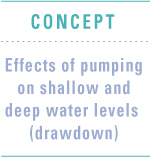 EFFECT
OF PUMPING ON SHALLOW AND DEEP WATER LEVELS IN SOUTHEASTERN WISCONSIN EFFECT
OF PUMPING ON SHALLOW AND DEEP WATER LEVELS IN SOUTHEASTERN WISCONSIN
Both the distribution and amount of pumping from shallow and deep rocks has
changed dramatically over time in southeastern Wisconsin. Here are two snapshots
of pumping for 1950 and 2000.
The effect of pumping on water levels is quite different for different depths
and aquifers in the ground-water flow system. For the Silurian dolomite, a shallow
aquifer that lies just below the loose glacial material but above the Maquoketa
shale, the lowering of water levels due to pumping is greatest in Ozaukee County
(north of Milwaukee) where developers have favored shallow wells. The wells draw
some of their water from Lake Michigan:
For the deep sandstone aquifer, water levels have dropped sharply with time
as the regional cone of depression has deepened and shifted west in response
to the locations of new wells and increase in total volumes of ground water pumped.
Compare the water levels simulated by the model in 1864, 1950 and 2000:
The ridge where the water levels are highest corresponds to the regional ground-water
divide.
Another way to examine historical changes in water levels is to graph profiles
of water levels in different rock units at different times. We have chosen to
show profiles for the water table in the loose glacial material, for the Maquoketa
shale that separates the shallow and deep parts of the flow system, and for the
St. Peter sandstone at the top of the deep sandstone aquifer. The profiles correspond
to a line that extends from Jefferson County through Waukesha and Milwaukee Counties
to the Lake:
The graphs show water-level profiles for the different units in 1864, 1950
and 2000. In each graph:
- The top green line is the land surface
- The blue line is the water table - it hardly changes through time.
- The purple line is the Maquoketa. It lies near the water table under natural
conditions, but drops below it in most places through time. Under natural conditions
it is above the land surface near Lake Michigan.
- The bottom yellow line is the St. Peter. Under natural conditions it is above
the land surface near Lake Michigan (corresponding to the existence of flowing
deep wells in the late 19th century). By year 2000, it is very far below he water
table except in the west:
The
profile representing the deep sandstone aquifer has not only changed its elevation,
but also its shape. Under natural conditions the slope of the line was toward
Lake Michigan, indicating flow in that direction. By year 2000 the slope of the
line is away from the Lake, indicating that ground water flows from under the
Lake toward inland pumping centers.
The ground-water model calculates water levels at many points in time between
1864 and 2000. This VIDEO CLIP (1445 kb) shows
evolving levels in the deep sandstone aquifer together with the shallow and deep
well configuration. In the video, colors refer to the water level levation in
feet above sea level (blue lowest, red highest). Maps only show southeastern
Wisconsin, but effect of Illinois pumping centers is evident in declining water
levels south of Milwaukee in Kenosha and Racine Counties.
The decline in water levels with time is called DRAWDOWN. The regional pattern
of drawdown is called the CONE OF DEPRESSION.
A VIDEO CLIP (837 kb) for conditions in the
deep sandstone aquifer shows that in the early period of development (~1900),
drawdown radiates from the Chicago area. Subsequently, a pumping center was established
in Milwaukee. Over time, the center of the drawdown cone widened and its center
moved west toward Waukesha county. In the video, the color scale refer to the
amount of drawdown in feet (blue least, red greatest); the topography and dip
of the surface corresponds to the top of the St. Peter formation; the view is
from south to north.
The model can also be used to project future drawdown given assumptions about volumes of future pumping. In one simple scenario we assumed that the well network throughout southeastern Wisconsin would be unchanged between 2000 and 2020, but that the pumping rates at each well would increase by 15-20% between 2000 and 2010 and by 30-40% between 2000 and 2020. The results are just one way to picture future conditions (and future relations between the ground-water system and Lake Michigan):
In summary, the regional ground-water system has changed and
continues to change:
- The major pumping center in southeastern Wisconsin has shifted
from the city of Milwaukee to cities in Waukesha County.
- The center of the cone of depression in the deep part of the flow system
has shifted westward about eight miles from Milwaukee to eastern Waukesha County
where deep water levels have dropped about 500 ft since the onset of pumping.
return to top |